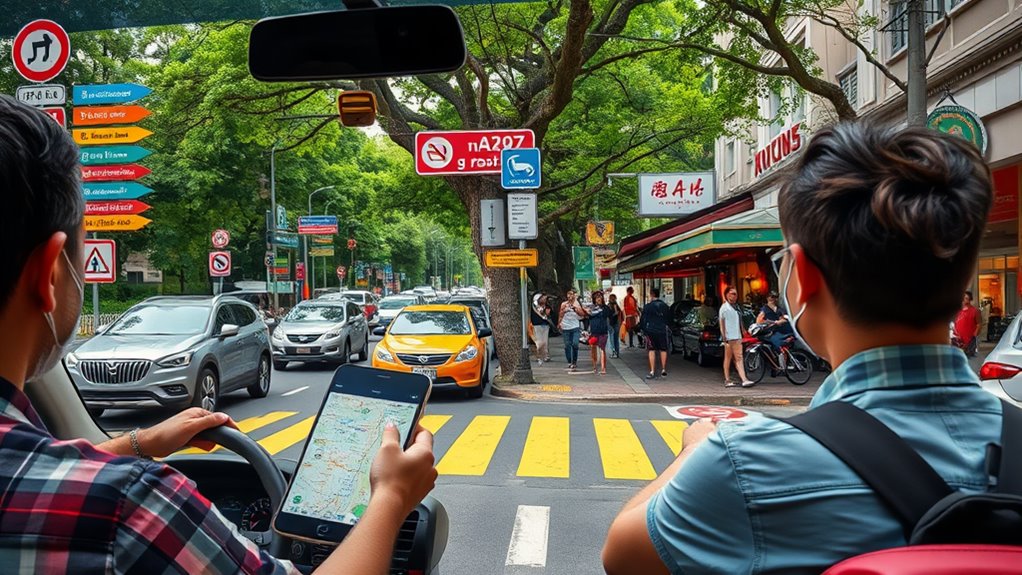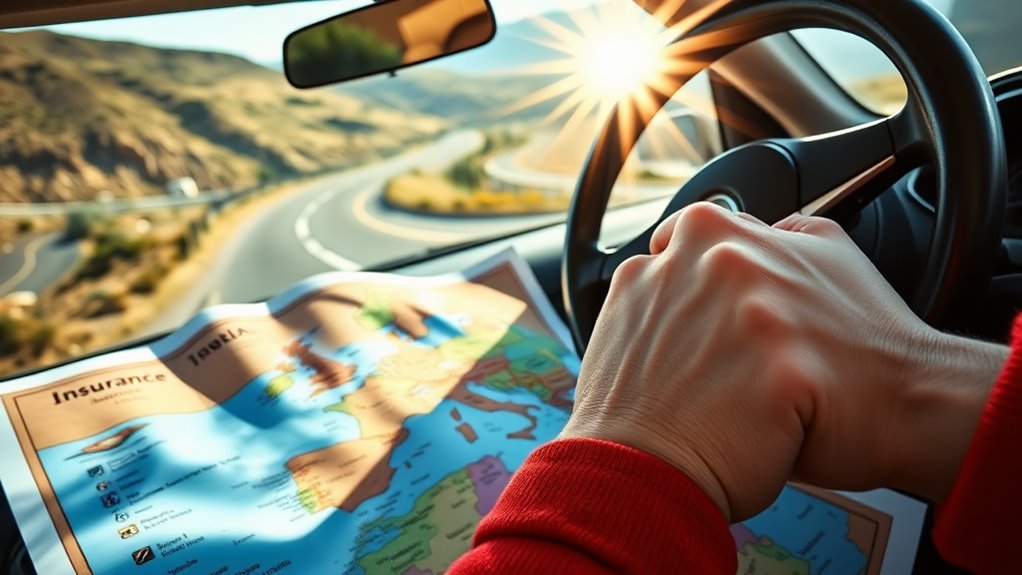When driving in foreign countries, it's crucial to research local traffic laws and understand road signs, as they may differ from what you're used to. Make sure your insurance covers international travel and familiarize yourself with local driving customs to avoid misunderstandings. Prepare for various weather conditions by checking your vehicle's readiness and packing an emergency kit. Finally, keep a list of emergency contacts handy, including local police and medical services. Staying informed and prepared will enhance your driving experience abroad. There's much more you can discover to navigate safely in unfamiliar territories.
Research Local Traffic Laws

Before you hit the road in a foreign country, it's crucial to familiarize yourself with local traffic laws. Each destination has its own rules governing international driving, and understanding these can save you from hefty legal penalties.
For instance, some countries have strict regulations regarding speed limits, seatbelt use, and mobile phone usage while driving. Ignoring these laws could lead to fines or even more severe consequences, such as license suspension or vehicle impoundment. Diversion safes, such as the Car Key Diversion Safe, can offer a discreet way to store valuables while traveling, which could be especially helpful in keeping important items secure in unfamiliar locations.
Additionally, you might need specific documentation, like an International Driving Permit, to legally drive. Take the time to research the requirements and regulations of your destination, ensuring a smoother and safer driving experience while avoiding unexpected legal troubles. Consider using an engine degreaser safe to discreetly store important documents or small valuables during your travels.
Understand Road Signs
When traversing roads in a foreign country, recognizing and understanding road signs is essential for your safety and compliance with local traffic regulations.
International road signs can differ considerably from what you're used to, so it's vital to familiarize yourself with these visual sign differences before hitting the road. Take time to study the shapes, colors, and symbols used in your destination. For example, a stop sign might look different, or warning signs may use symbols instead of words.
You can easily find resources online or in travel guides to help you decode these signs. By understanding them, you'll navigate more confidently and reduce the risk of accidents or misunderstandings while driving abroad. Additionally, having a compact tool like the Lipstick Stun Gun on hand can enhance your personal safety during your travels. Consider carrying a high-quality flashlight stun gun, like the Safety Technology Shorty Flashlight Stun Gun, for added security in unfamiliar environments.
Check Insurance Requirements

Understanding road signs is just the beginning of guaranteeing a safe driving experience abroad; checking insurance requirements is equally important. Each country has different insurance coverage standards and international regulations. Before you hit the road, confirm that your current policy extends coverage overseas or consider purchasing local insurance. Failing to meet these requirements can lead to hefty fines or worse.
| Country | Minimum Insurance Coverage | Special Notes |
|---|---|---|
| France | Third-party liability | Consider collision coverage |
| Spain | Third-party liability | Verify with your provider |
| Italy | Third-party liability | Local insurance recommended |
| Australia | Extensive coverage | Check for personal injury |
Stay informed to guarantee a smooth drive in unfamiliar territories!
Familiarize Yourself With Driving Customs
Getting to grips with local driving customs can make all the difference in ensuring a safe journey abroad. Every country has its own set of rules and norms, influenced by cultural driving differences.
For instance, in some places, it's common to yield to pedestrians, while in others, they may have to wait for vehicles. Understanding international road etiquette, like when to use your horn or how to approach roundabouts, is essential.
Additionally, be aware of local signs and signals, as they can vary greatly. Take some time to research these customs before you hit the road, and consider asking locals for tips.
This knowledge will help you navigate more confidently and avoid misunderstandings that could lead to accidents.
Prepare for Different Weather Conditions

Preparing for different weather conditions is vital for safe driving abroad. Before hitting the road, check your vehicle readiness. Verify your tires are in good condition, with proper tread depth and inflation. Tire maintenance is important, especially if you're traveling in areas prone to rain, snow, or icy conditions.
Consider switching to winter tires if you're visiting cold climates.
Additionally, familiarize yourself with local weather patterns. Know that flash floods, heavy winds, or fog can impact driving, and adjust your plans accordingly. Keep your windshield wipers functioning and your washer fluid topped off.
Always pack an emergency kit, including blankets and a flashlight, in case you encounter severe weather. Being prepared won't only enhance safety but also make your driving experience smoother.
Keep Emergency Contacts Handy
Having a list of emergency contacts readily available can make a significant difference in a crisis while driving abroad. Before you hit the road, jot down important emergency numbers for the country you're visiting. This includes local police, fire departments, and medical services, which can differ from what you're used to at home.
Don't forget to include the contact information for your local embassies; they can provide critical assistance if you encounter serious issues. Keep this list in an easily accessible spot, like your glove compartment or on your phone.
In emergencies, every second counts, and having these contacts handy can help you stay calm and guarantee you get the help you need without delay.
Frequently Asked Questions
What Should I Do if I Get Into an Accident Abroad?
If you get into an accident abroad, document everything thoroughly—take photos and gather witness information. Contact your insurance provider immediately to start claims and guarantee you understand local laws regarding accidents and liability.
Are There Specific Driving Apps Recommended for Foreign Countries?
When driving abroad, you'll find navigation tools like Google Maps and Waze invaluable. Fuel apps such as GasBuddy can help you locate the best prices nearby. These tools make your journey smoother and more efficient.
Can I Use My Home Country's Driver's License?
You can use your home country's driver's license, but check the international license requirements first. Familiarize yourself with local driving regulations, as rules vary widely and might require an international driving permit for legality.
How Can I Find Local Roadside Assistance?
To find local roadside assistance, check your vehicle's manual for emergency contacts, or search online for local resources. You can also ask locals for recommendations, ensuring you're prepared for any unforeseen issues while driving.
What Are Common Driving Etiquette Tips in Different Cultures?
When driving, be aware of cultural differences in etiquette. For instance, some countries expect you to yield to pedestrians, while others prioritize road signs. Always observe local customs to guarantee a respectful driving experience.
So Here Is What We Learned
Driving in a foreign country can be an exciting adventure, but being prepared is key. By researching local traffic laws, understanding road signs, and knowing insurance requirements, you'll set yourself up for a smoother experience. Familiarizing yourself with driving customs and preparing for various weather conditions will help keep you safe on the road. Don't forget to keep emergency contacts handy, just in case. With these tips in mind, you're ready to hit the road with confidence!




